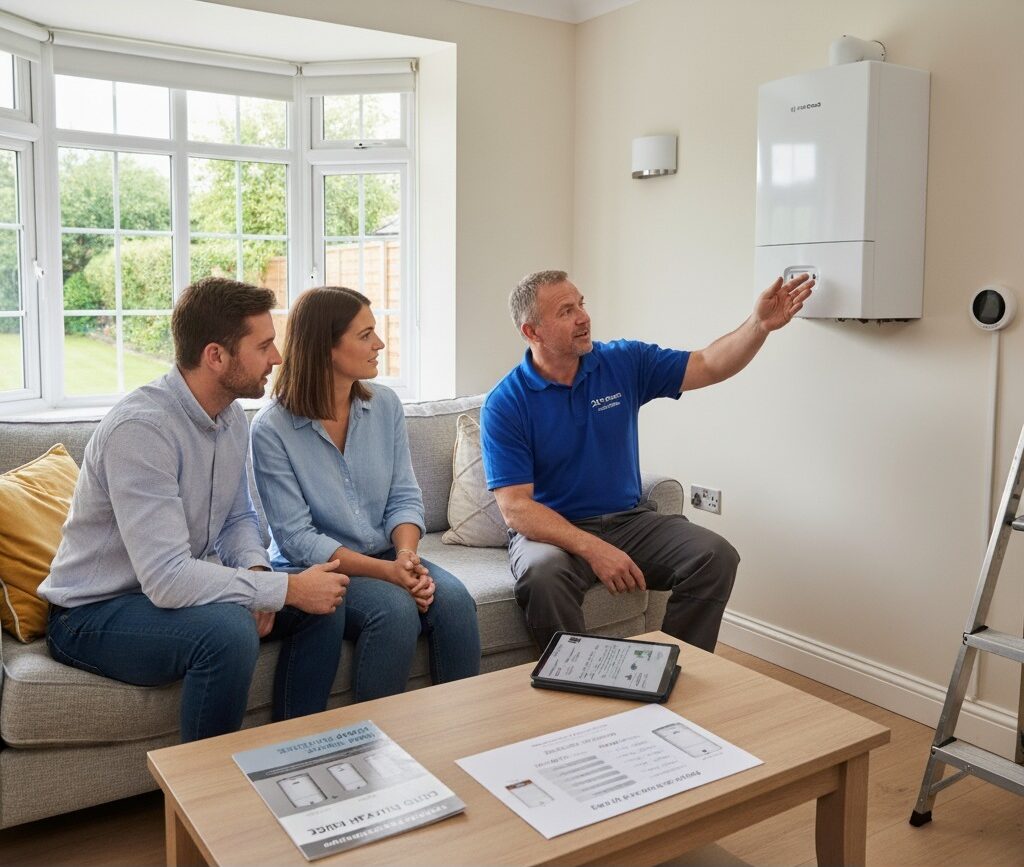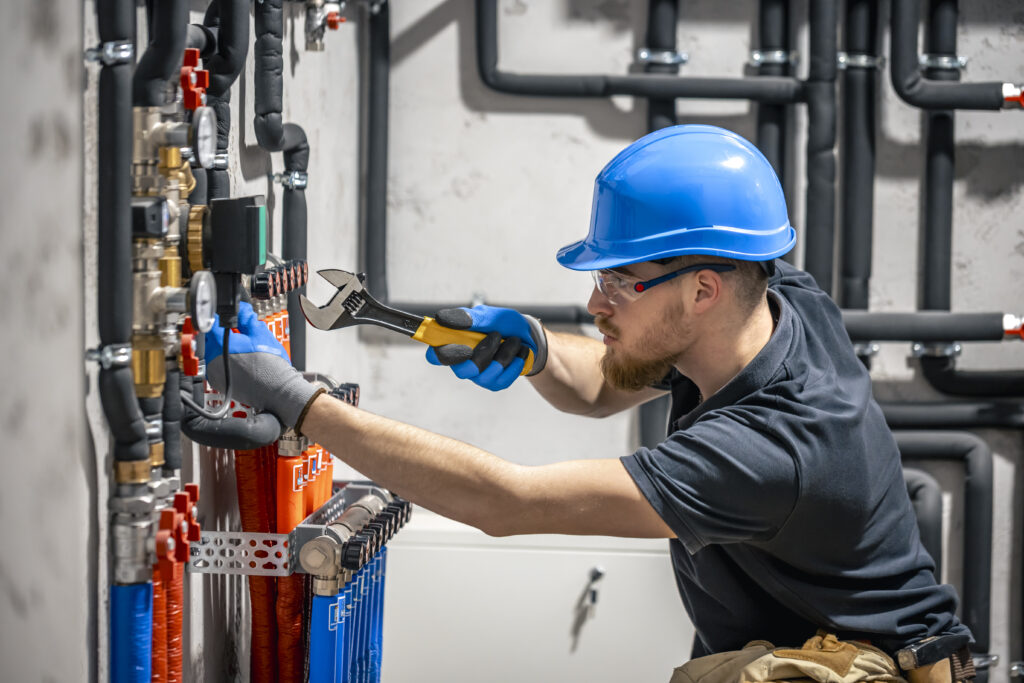How to Reduce Boiler Pressure Safely

Boiler pressure too high? This UK-focused guide shows you how to reduce boiler pressure on a combi boiler (and other sealed systems) safely and quickly without touching the pressure relief valve (PRV). We’ll cover what normal boiler pressure is, how to check the pressure gauge (in bar), the safest ways to lower boiler pressure (bleeding a radiator or using a drain‑off valve), and what to do if the gauge hits 2.5–3 bar. You’ll also learn why boiler pressure keeps rising, how to close the filling loop properly, and when to call a Gas Safe engineer.
Quick Fix: Lower Boiler Pressure in Minutes
- Time: 10–20 minutes
- Skill: Beginner
- Works for: Most combi/sealed systems (Worcester Bosch, Vaillant, Ideal, Baxi)
- Tools: Radiator bleed key, towel and container, flathead screwdriver (some loops), gloves; hosepipe if using a drain‑off valve
Steps:
- Power off and cool. Turn the boiler off and let it cool for 30–60 minutes. Check boiler pressure on the gauge/manometer (bar). If it’s around 2.5 bar cold, that’s high. At ~3 bar, the PRV may discharge via the outside pipe.
- Close the filling loop fully. Find the filling loop (external braided hose or internal/keyless link). Close both isolation valves and refit blanking caps. If pressure rises even when the boiler is off, a valve may be passing/stuck.
- Bleed a radiator or towel rail. Use a radiator key to release a little air/water and lower boiler pressure. Watch the gauge as you go.
- Aim for the safe range. Normal boiler pressure when cold is typically 1.0–1.5 bar (check your manual for what should boiler pressure be on your model).
- If you drop too low, repressurise once. If you fall below ~1.0 bar, gently increase/top up boiler pressure using the filling loop to ~1.2–1.3 bar, then close the loop so pressure doesn’t keep rising.
What is Normal Boiler Pressure? (Cold vs Hot)
Understanding normal ranges helps you decide whether to lower or increase pressure.
- Cold (heating off): About 1.0–1.5 bar. Many homeowners aim for ~1.2–1.3 bar cold.
- Hot (heating on): Often 1.5–2.0+ bar. Boiler pressure should rise when heating is on, but not near the red zone.
- Is 2.5 bar too high? Hot, 2.5 bar is borderline. Monitor closely.
- Boiler pressure 3 bar: Turn the heating off, let it cool, and reduce boiler pressure safely.
- Tip: Some gauges show a red zone near the top. Hitting it can open the PRV (you’ll see the discharge pipe dripping outside).
Identify Your Boiler and Filling Loop Type
Your approach to reducing pressure on a combi boiler is the same, but closing the loop differs by design.
- External braided filling loop (two valves + caps): A short flexible hose under the boiler or nearby pipework with two isolation valves (levers or slot-head screws). To shut: turn both valves fully closed, then refit blanking caps.
- Internal/hidden loops and “keyless filling link” (Worcester Greenstar): A small lever under the boiler release to stop topping up. If pressure keeps rising while off, the internal valve might be passing.
- Vaillant ecoTEC, Ideal Logic, Baxi: Typically twin knobs or an external loop. Ensure both ends are fully closed.
- Don’t open the boiler case to find an internal loop, check the manual or call a professional.
Method 1: Close the Filling Loop Properly
A filling loop left open is the most common reason boiler pressure keeps rising.
- Locate the loop and both valves. Levers should sit across the pipe when closed; slot-head screws turn 90° so the slot is perpendicular. Knobs turn clockwise to the stop.
- Refit blanking caps. Caps help the double check valves seal and prevent pressure creep.
- Check for gauge creep. With the system off and cool, watch the needle for 10–20 minutes. If it climbs, a valve may be passing.
- Internal auto‑fill valves (keyless links). If a lever returns but pressure still rises, the internal valve may be stuck/passing. Don’t open the case book an engineer.
Method 2: Bleed a Radiator or Towel Rail to Lower Pressure
This is the safest way to lower boiler pressure without using the PRV lever.
- Prep: Boiler off and cool, radiator bleed key, towel/container, gloves.
- Which radiator to bleed first? Start upstairs (air rises), ideally the one farthest from the boiler. Towel rails work well too.
- How to do it: Crack the bleed screw a quarter turn, release a little air/water, then close. Recheck the gauge (bar). Aim for 1.0–1.5 bar cold.
- How much to bleed to drop ~0.5 bar? Go in 3–5 second bursts and recheck. On a small system, a few hundred millilitres might lower 0.3–0.5 bar, but systems vary.
- If you go too low: Repressurise a boiler once via the filling loop to ~1.2–1.3 bar, then close both valves and caps.
Method 3: Drain a Small Amount via a Drain‑off Valve
If radiators don’t have much air, use a drain cock to reduce boiler pressure.
- Find the drain‑off valve: Usually low down near the boiler, on a downstairs radiator, or on a low pipe run.
- Tools: Hosepipe to a drain/bucket, spanner, towel, gloves.
- Steps: Attach a hose, crack the valve gently, release a small amount, close and recheck the gauge. Aim to land in the safe pressure range (1.0–1.5 bar cold).
- Minimise water waste: Short, controlled releases. Avoid draining litres at once.
- Avoid this method if the valve is corroded/seized or won’t reseal cleanly, call a pro.
Emergency Steps if Pressure Hits 3 Bar or the PRV is Discharging
- Turn the heating off and let it cool.
- Close the filling loop fully. If pressure rises even when off, a valve is likely passing.
- Lower pressure safely: Bleed a radiator (or use the drain‑off valve) to bring it back to ~1.2–1.5 bar cold.
- Do not flip the PRV lever to dump pressure this can make it stick open and leak through the discharge pipe.
- If the PRV pipe keeps dripping outside or you see big swings (e.g., 0.8 bar cold → 3.0 bar hot), call a Gas Safe engineer.
Troubleshooting: Why Does My Boiler Pressure Keep Rising?
| Symptom | Likely Cause | Action |
|---|---|---|
| Pressure rises only when heating is on | Faulty/undercharged expansion vessel. | Call a Gas Safe engineer. They can recharge or replace the vessel. |
| Pressure rises even when the boiler is off | Filling loop left open or a stuck auto-fill valve. | Close the loop properly. If pressure still creeps, the valve is passing needs professional replacement. |
| Pressure is too high after you’ve topped up | System was overfilled. | Bleed a radiator to lower the pressure to the correct level. |
| Pressure fluctuates wildly | Faulty pressure gauge or sensor. | Call a Gas Safe engineer to test and replace the component. |
| Pressure drops overnight (losing pressure) | A leak in the system, a weeping PRV, or air. | Check for visible leaks. If you’re frequently topping up, you likely have a leak that needs professional diagnosis. |
Aftercare: Monitor and Prevent Recurrence
- Set a cold target: Aim for ~1.2–1.3 bar cold; avoid overfilling above ~1.5 bar.
- Keep a simple 7‑day pressure log: Record cold/hot readings and any actions (bled/topped up). Patterns help diagnose expansion vessel or filling loop issues.
- Close the filling loop every time: Both valves shut, caps refitted. On Worcester keyless links, ensure the lever returns fully.
- Check the outside discharge pipe: It should be dry. Persistent drips mean the PRV is passing.
- Limit frequent top-ups: Each top-up adds oxygen (corrosion/sludge risk). Fix leaks, top up in small increments, and bleed air properly.
- Annual service: Ask for expansion vessel check, PRV inspection, filling loop integrity, leak check, inhibitor top-up, and a sanity check on the gauge/sensor.
Myths and Bad Advice to Avoid
- “Just pull the PRV lever to dump pressure.”
Don’t, PRVs can stick open and leak via the discharge pipe. - “Open the boiler case and tweak internal parts.”
No, only Gas Safe engineers should work inside. - “Drain lots of water quickly.”
Over‑draining makes you overfill again; use short, controlled releases and watch the gauge.
UK Compliance and Warranty Notes
- Gas Safe rules: Homeowners can check the gauge, operate external filling loops, and bleed radiators. Do not remove the boiler case or adjust internal components.
- Water Regulations: Filling loops should include a double check valve and be closed after use.
- Tenants/landlords: If pressure keeps rising or you’re topping up frequently, report it.
- Warranty: Frequent overpressurising or using the PRV as a tap can affect warranties, follow the manual.
Brand Quick References (Finding the Filling Loop)
- Worcester Bosch (Greenstar/keyless filling link): Lever under the boiler, hold to top up; release to stop. Make sure it returns fully.
- Vaillant ecoTEC: Often twin grey/black knobs under the boiler or an external braided loop, close both.
- Ideal Logic: Usually, an external braided loop under the casing, look for two isolation valves.
Baxi: Mixed setups; many use an external loop. If you can’t locate it, check your manual.
- Note: Don’t open the case to access internal loops, call a professional.
FAQs
Typically 1.0–1.5 bar cold and around 1.5–2.0+ bar hot.
Hot, it’s borderline. If the boiler is hot, 2.5 bar is high but usually acceptable. If the boiler is cold and the pressure is at 2.5 bar, it is definitely too high and needs to be reduced immediately.
You know it’s closed when both isolation valves are shut (levers perpendicular to the pipe, or knobs fully clockwise) and the blanking caps are fitted. The definitive check is to monitor the gauge when the boiler is off and cold; if the needle doesn't move or "creep" up after 10–20 minutes, the loop is sealed.
Important Reminders
Always let the system cool before releasing pressure.
Avoid using the PRV lever to lower pressure.
If boiler pressure reaches ~3 bar, if the PRV pipe is dripping outside, or if pressure keeps rising despite the boiler being off, call a Gas Safe engineer.




